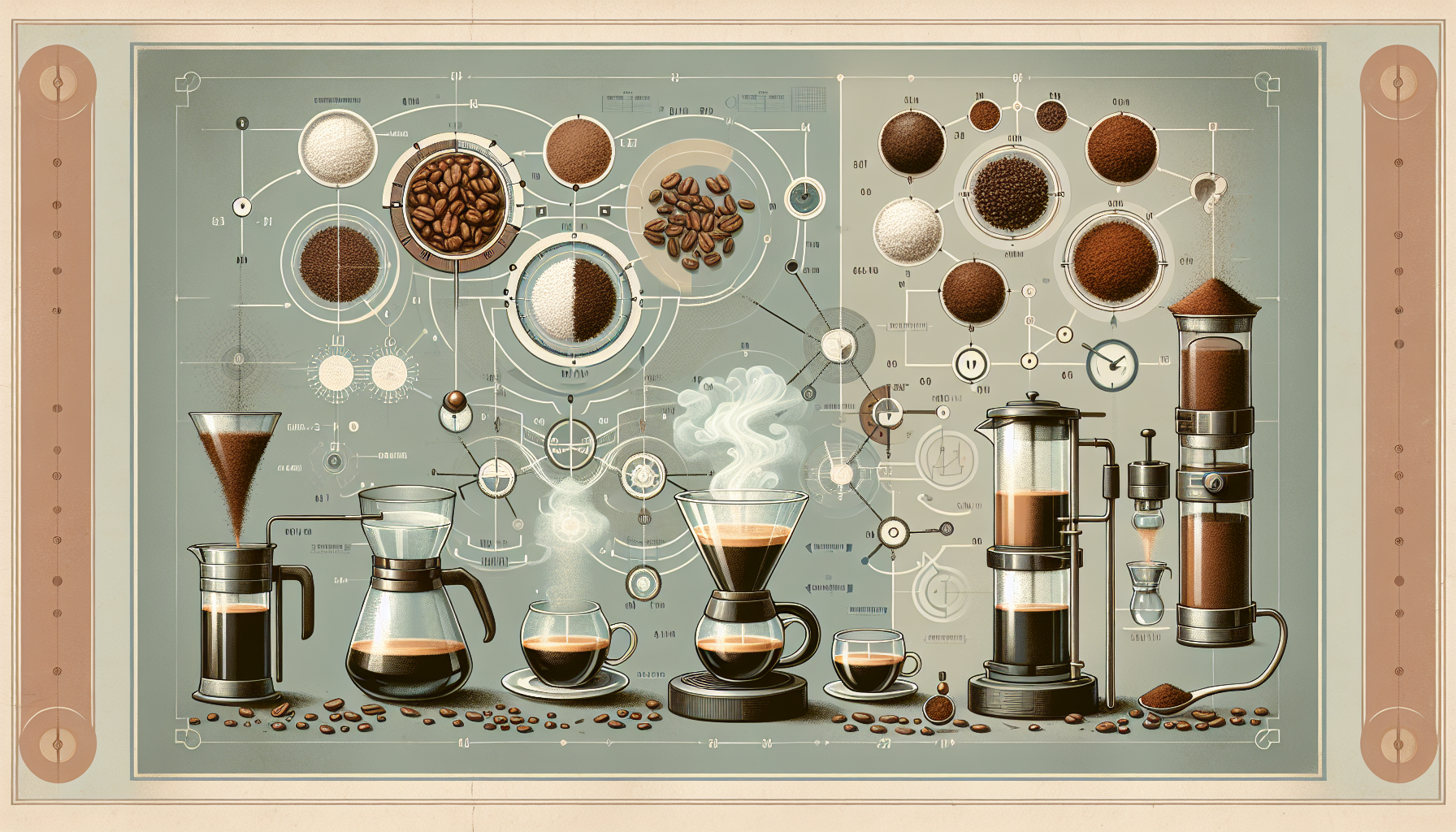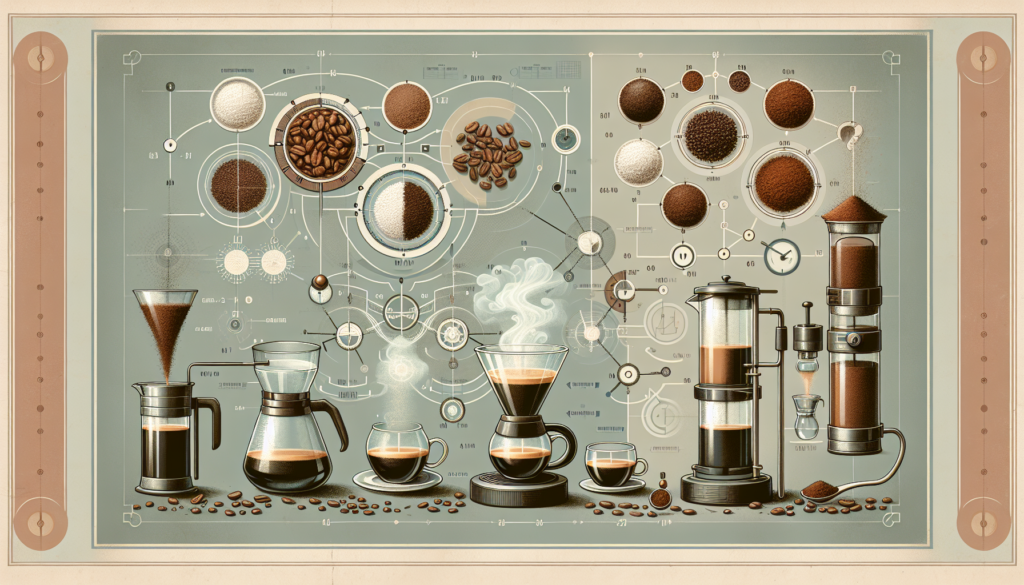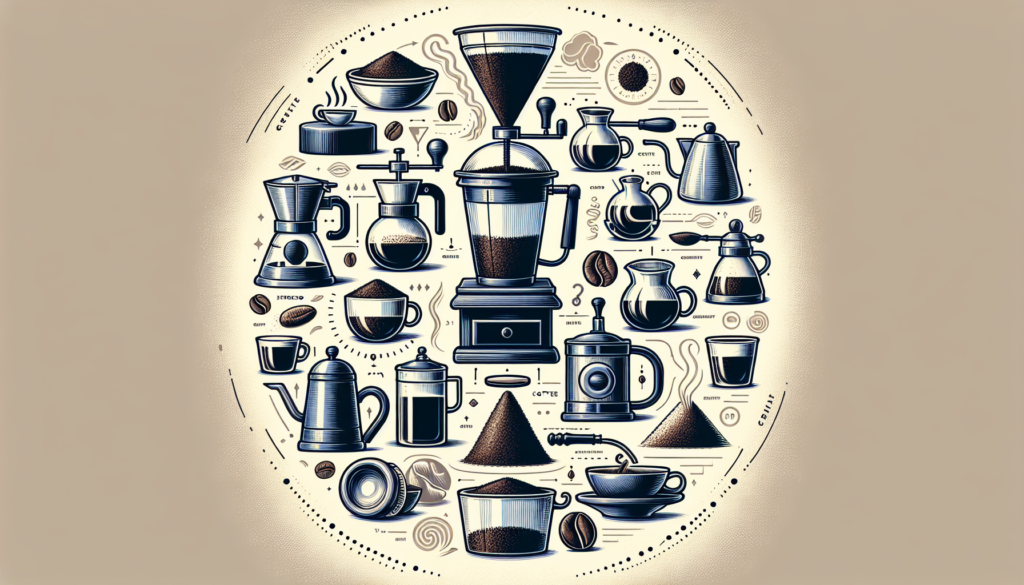
Are you tired of subpar coffee? Do you long for that perfect cup of espresso or French press coffee that can transport you to coffee heaven? Well, look no further, because in this article, we will guide you on how to achieve the perfect grind for different coffee brewing methods. Whether you are an espresso lover or prefer the full-bodied flavors of French press, we’ve got you covered. Get ready to elevate your coffee game and enjoy a morning ritual that will make you the envy of all coffee enthusiasts. So grab your grinder and let’s dive into the world of achieving the perfect grind for your favorite coffee brewing methods!

Espresso
Espresso is a beloved and complex coffee beverage that requires precision and care to achieve the perfect brew. One of the key factors in creating a delicious espresso shot is selecting the right grinder. A high-quality grinder is essential for extracting the rich flavors and oils from the coffee beans, ensuring a smooth and balanced espresso. When choosing a grinder for espresso, there are a few factors to consider.
Choosing the right grinder
The grinder you select for your espresso-making endeavors can significantly impact the quality and taste of your brew. It is recommended to invest in a burr grinder rather than a blade grinder, as burr grinders offer a more consistent grind size and produce less heat, preserving the delicate flavors of the coffee beans. Look for a grinder with a sturdy construction, adjustable grind settings, and a reputation for reliability.
Understanding the ideal grind size
The grind size plays a crucial role in espresso extraction. For espresso, a fine grind is generally preferred. The grounds should resemble granulated sugar or fine sand. A finer grind allows for more surface area and enables the flavors and aromas to be extracted quickly during the brewing process. However, it is essential to find the right balance, as a grind that is too fine can result in over-extraction and a bitter taste.
Adjusting grind settings
Once you have selected a suitable grinder, it’s time to dial in the perfect grind size for your espresso. Start with a medium-fine grind and make adjustments based on the taste and extraction time of your shots. If your espresso tastes sour or under-extracted, try a slightly finer grind. Conversely, if it tastes bitter or over-extracted, coarsen the grind. Keep in mind that small adjustments can make a significant difference in flavor, so be patient and experiment until you find the sweet spot.
Ensuring consistency
Consistency is key when it comes to grinding coffee for espresso. To achieve consistent results, it is essential to maintain the same grind size and weight for each shot. Inconsistent particle sizes can lead to uneven extraction and a less balanced espresso. Invest in a grinder that offers precise grind settings and make sure to use a scale to measure the coffee dose accurately. Additionally, regularly clean your grinder to remove any residue that may affect the flavor of your espresso.
Dos and don’ts for espresso grinding
When grinding coffee for espresso, there are a few dos and don’ts to keep in mind. Do use fresh, high-quality beans and grind them just before brewing for the best results. Do experiment with different grind sizes and adjust accordingly to achieve your desired flavor profile. Don’t use a blade grinder, as it can produce an inconsistent grind size and generate excess heat. Don’t neglect cleaning your grinder regularly to ensure optimal performance and taste. With these tips in mind, you’ll be on your way to brewing exceptional espressos at home.
French Press
The French press is a classic brewing method loved by coffee enthusiasts for its full-bodied and robust flavor. To achieve the perfect French press brew, selecting the appropriate grinder is essential. The right grinder will help you achieve a consistent and evenly sized grind, allowing for optimal extraction of flavors from the coffee beans.
Selecting the appropriate grinder
For French press brewing, a burr grinder is highly recommended. Burr grinders provide a more consistent grind size compared to blade grinders, resulting in a more uniform extraction. Look for a grinder that allows for adjustments to the grind size and offers a coarse setting suitable for French press brewing. Additionally, consider the durability and reliability of the grinder to ensure it will meet your brewing needs.
Optimal grind size for French press
The French press requires a coarse grind to prevent over-extraction and sediment in the final cup. The coarse grind allows for a longer steeping time, giving the coffee ample opportunity to release its flavors. The grounds should resemble coarse sea salt, providing enough surface area for proper extraction while avoiding excessive bitterness.
Fine-tuning grind settings
Achieving the desired flavor profile with your French press brew may require some fine-tuning of the grind settings. If the coffee tastes weak or under-extracted, try adjusting to a slightly finer grind. On the other hand, if it tastes bitter or over-extracted, try a coarser grind. Keep in mind that the brewing time and water temperature also play a role in the final taste, so it may be necessary to adjust those variables as well.
Maintaining uniformity
Consistency in grind size is crucial for French press brewing. To ensure even extraction and a balanced cup, it is essential to maintain uniform particle size. Invest in a grinder that offers precise settings and make sure to grind your coffee beans using the same setting each time. Additionally, consider using a sieve or sifter to remove any small particles that can contribute to excessive bitterness or sediment.
Tips for French press grinding
When grinding coffee for French press, there are a few tips and techniques that can elevate your brewing experience. Consider preheating your French press to maintain a consistent brewing temperature. Experiment with different coffee-to-water ratios to find your preferred strength. Finally, pour the brewed coffee into a separate container to prevent over-extraction and maintain the desired flavor profile. With these tips in mind, you’ll be on your way to enjoying a perfect French press brew.

Pour Over
Pour over brewing is a popular method for extracting the subtle nuances and delicate flavors of specialty coffee. To achieve a precise and balanced pour over, selecting a suitable grinder is crucial. The right grinder will allow you to control the extraction process, ensuring an even flow of water through the coffee grounds and an optimal flavor profile.
Selecting a suitable grinder
For pour over brewing, a grinder that offers precise grind settings is essential. Look for a burr grinder with the ability to adjust the grind size to meet your specific pour over method requirements. Consider the grinder’s construction, durability, and reputation for producing consistent results. Investing in a high-quality grinder will significantly impact the overall quality of your pour over brew.
Determining the best grind size
The ideal grind size for pour over brewing depends on the specific pour over method you are using. Generally, a medium-fine to medium grind is recommended for pour over, similar to refined table salt. However, different pour over devices may have slightly different requirements. Experiment with different grind sizes to find the one that produces the desired flavor profile and extraction time for your pour over brew.
Fine adjustments for pour over
Once you have determined the initial grind size, it may be necessary to make fine adjustments based on taste and extraction time. If your coffee tastes weak or under-extracted, try a slightly finer grind. Conversely, if it tastes bitter or over-extracted, coarsen the grind. It is essential to make small adjustments and monitor the results carefully to achieve the desired balance and flavor in your pour over brew.
Maintaining even particle size
To ensure a consistent and balanced pour over brew, maintaining an even particle size is crucial. Inconsistent grind sizes can lead to over-extraction or under-extraction, resulting in an unbalanced flavor profile. Invest in a grinder that offers precise settings and make sure to grind your coffee beans using the same setting consistently. Additionally, consider using a sieve or sifter to remove any unwanted fines that can affect the overall taste of your pour over coffee.
Useful techniques for pour over grinding
When grinding coffee for pour over brewing, there are a few techniques that can enhance your brewing experience. Consider pre-wetting your coffee filter before brewing to remove any paper taste and to ensure even water distribution. Experiment with different pouring techniques, such as the classic concentric circles or the pulse-pouring method, to control the flow rate and extraction. Finally, take note of the brew time and adjust your grind size accordingly to achieve optimal results. By employing these techniques, you’ll be able to create a pour over brew that highlights the unique flavors of your coffee.